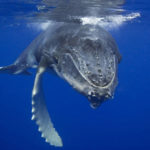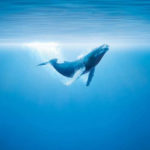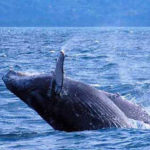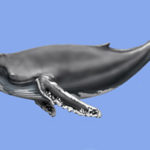Facts about sperm whales
 Sperm whale is the only modern representative of the family of sperm whales. These whales have a huge head of a rectangular shape. Among other large cetaceans, the sperm whale is distinguished by a number of unique anatomical features. To your attention 31 interesting fact about sperm whales.
Sperm whale is the only modern representative of the family of sperm whales. These whales have a huge head of a rectangular shape. Among other large cetaceans, the sperm whale is distinguished by a number of unique anatomical features. To your attention 31 interesting fact about sperm whales.
- Sperm whale is the largest toothed whale. Adult males weigh about 50 tons and reach 20 meters in length. They grow throughout life.
- Female grows up to 15 meters in length with a body weight of 20 tons. Sperm whales have well-defined sexual dimorphism. In addition to the fact that females are smaller in size than males, they also have a different physique, the number of teeth and the shape of the head.
- The first scientific description of the sperm whale was given by Carl Linnaeus.
- The third part of the sperm whale’s body is made up of a head, so it is difficult to confuse it with other cetaceans.
- The skin color of sperm whales varies from blue to dark gray. In coloring, brown tones are often present. Some males near the fins have yellow or white spots. Researchers also recorded the observation of albino sperm whales.
- In sperm whales, the skin on the belly can reach a thickness of 50 cm.
- Sperm whale teeth are a valuable bone. At the time of whale extraction, they served as an expensive ornamental material, which was valued on a par with the walrus tusk and the mammoth tusk.
- One whale tooth can weigh up to 2 kg.
- Among all mammals, the sperm whale has the largest brain. Its mass is about 8 kg.
- In the head, sperm whales have a unique formation – a spermacetal sack (fat pad). The weight of this transparent liquid can reach 5 tons. Spermaceti is a waxy substance that solidifies in the air. “Sperm Whisker” is used in the pharmaceutical and perfume industries.
- Sperm whales do not have olfactory organs, but they have unsurpassed hearing. Whales find food by ultrasonic echolocation (like bats).
- Sperm whales live in herds. They combine into groups of several hundred, and sometimes thousands of heads. Whales collectively hunt and migrate in winter to warm latitudes. Very old sperm whales usually stay alone.
- Spermacetal whales publish 3 types of sounds – crackling, moaning and clicking. The voice of the sperm whale is very loud, the sounds reach 115 dB. Whales from different groups use different sound markers. Scientists believe that there are several dialects in the “language” of these animals.
- Sperm whales swim at a speed of about 7 km / h. In comparison with baleen whales, this is slow. Researchers note, sperm whales can develop a speed of up to 30 km / h, if something is scared.
- In the largest toothed whales, the unique structure of internal organs. The device of the intestine of the sperm whale is greatly simplified, but its length reaches 160 m. The stomach of the marine giant contains 500 liters of liquid.
- In the digestive tract of male sperm whales a solid substance of gray color – ambergris is formed. It is a valuable product (fragrant substance), which is used in the production of perfume. From ambergris qualitative fixers of aromas turn out.
- In the period of active whaling, people hunted sperm whales not only for the sake of spermacetas, ambergris and teeth. The main product of sperm whale was fat. Also, people used whale meat. In food it was not consumed because of a sharp unpleasant smell, the meat served as feed for dogs and animals with valuable fur.
- Live in the intestine of the sperm whale, beltworms up to 30 m long.
- Sperm whale can be under water longer than all mammals. Researchers recorded the presence of the whale under water for 1 hour and 52 minutes. In addition, animals can dive to a depth of up to 2500 meters at a pressure of 100 atmospheres.
- Respiratory functions in sperm whales are performed by the left nostril. It is located in front of the head on the left. The right nostril thanks to a special valve only lets in the air, but does not let it out.



























